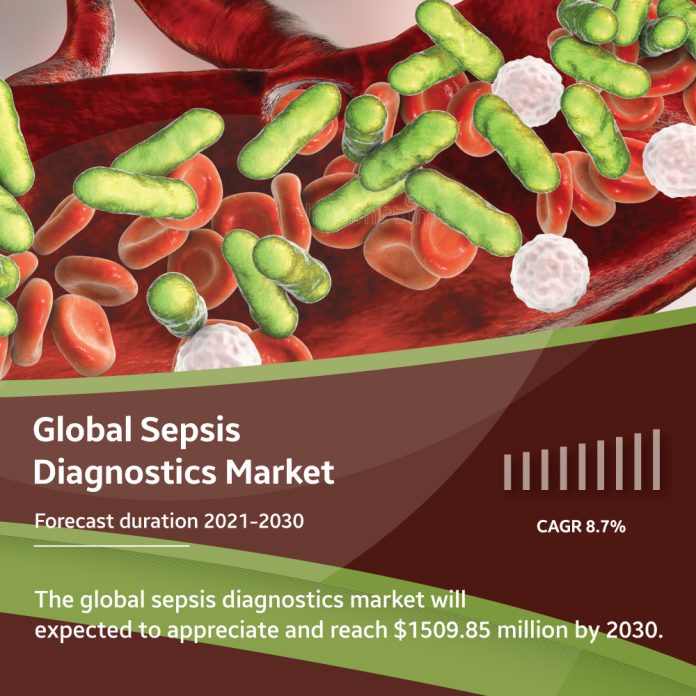The medical condition sepsis is caused by the body’s reaction to infections brought on by bacteria, viruses, or fungi. In this circumstance, the immune system releases a number of chemicals into the bloodstream, leading to hyperinflammation and the formation of blood clots. Sepsis can lead to multiple organ failures, fast breathing, low blood pressure, neurological dysfunction, and an elevated heart rate. Sepsis is diagnosed using a variety of techniques, including microfluidics, flow cytometry, immunoassays, and molecular diagnostics.
The market worth of sepsis diagnostics in 2021 was USD 712.74 million, and by 2030 it will be worth USD 1509.85 million at an 8.7% CAGR during 2021-2030.
The major drivers are the desire for high levels of diagnostic precision and accuracy and an increase in regulatory approvals of crucial diagnostic solutions. The high rates of sepsis and greater hospital stay expenses will accelerate market expansion. Additionally, the desire for precise results and a rapid response time is promoting the development of sepsis molecular diagnostics.
Market Overview
Rapid approval of critical sepsis diagnostics and treatment options by regulatory authorities worldwide, most notably the US Food and Drug Administration, has resulted in an increase in the launch of sepsis diagnostic tools. This has propelled the expansion of the market for sepsis diagnostics. Additionally, the COVID-19 pandemic’s effects on respiratory problems and lung sepsis have helped the market expand. The number of hospitalizations caused by COVID-19 has increased, which has expanded the market’s potential for growth. Furthermore, the increasing prevalence of sepsis in various high-income countries has resulted in the introduction of new sepsis diagnostic products to the market. Additionally, governments worldwide are actively putting out ideas and starting campaigns to promote the use of contemporary sepsis diagnostic technology.
Furthermore, the increased prevalence of sepsis-related hospital-acquired illnesses such as urinary tract infections and surgical site infections will boost the growth of the sepsis diagnostics market. Furthermore, individuals with septic disorders account for a large proportion of hospitalizations. Ultimately, these factors will increase the usage of sepsis diagnostic tools during the forecast period.
Furthermore, Outside of intensive care medicine, the majority of clinical practitioners and emergency physicians are not familiar with sepsis. One of the main issues in sepsis management is a lack of education about the condition.
Market Segmentation
On the basis of product, the sepsis diagnostic market has been divided into three product categories: instruments, blood culture media, and test kits & reagents.
The largest market was contributed by the blood culture media product segment in 2021, with 45.5% of the revenue share. It is because clinicians see blood culture as the most accessible and cost-effective way of diagnostics.
On the basis of technology, the microbiology market segment maintained the largest position in the market, with 48.5% of the revenue share. It is because the use of culture media tests in microbiology technology enables precise detection and identification of microorganisms for sepsis diagnosis. New strategic initiatives by important players are also stimulating market expansion.
On the basis of the pathogen, the market segment comprises bacterial sepsis, fungal sepsis, and other pathogen-based sepsis. The bacterial sepsis segment held the highest market share of 79.5% in 2021. It is due to the rise in bacterial sepsis cases, the increased frequency of hospital-transmitted infections, and the increasing number of surgical procedures performed. Bacterial sepsis is the most frequent form, with 62.2% of patients having gram-negative bacteria and 46.8% having gram-positive bacteria, according to a report released by SAGE Journals in January 2019.
On the basis of testing type, the market segment comprises laboratory testing and point-of-contact testing. With a market share of more than 85.00% in 2021, the laboratory testing type segment ruled the overall. This is primarily because lab testing is more accurate than POC testing when detecting sepsis. Clinical laboratory testing allows a thorough examination of the pathogen and its medication resistance profile. Furthermore, routine testing of lactate levels, which are nonspecific but useful markers of sepsis, is performed effectively in laboratory settings.
Regional Analysis
North America ruled the overall market in 2021 with 39.7% of the revenue share. The largest market share is due to a well-established medical infrastructure, which has increased the region’s use of modern diagnostic technologies. Furthermore, this region’s important competitors and favorable reimbursement system are driving market expansion. Furthermore, the rising prevalence of sepsis and infectious disorders will drive demand for novel diagnostic methods.
From 2022 to 2030, Asia Pacific will be a rapidly growing geographical market. Middle East Africa will also rise significantly owing to increased demand for sepsis diagnostic solutions in countries with high infectious illness prevalence, such as Algeria and Morocco.
Key Players
- Thermo Fisher Scientific, Inc.
- F. Hoffmann-La Roche AG
- BioMérieux SA
- Mckesson Corporation
- Cerner Corporation
- Becton, Dickinson, and Company
- Danaher Corporation (Beckman Coulter, Inc.)
- Wolters Kluwer NV.
- Amara Health Analytics
- Bruker Corporation
- Luminex Corporation
- GE Healthcare
- Epic Systems Corporation
- Koninklijke Philips N.V.

